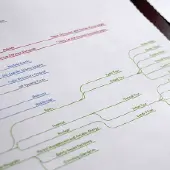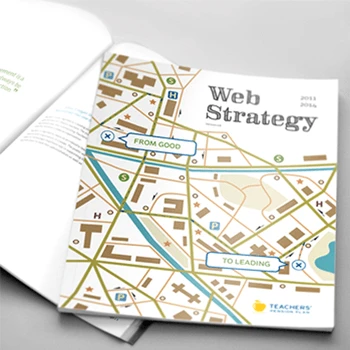What exactly is web content mapping and why do organizations need it?
Web content mapping is a strategic process that documents how all your current content will migrate to a new web presence. It involves analyzing what content you have, where it currently lives, and determining where it should live in your new architecture. Organizations with hundreds or thousands of pages need content mapping services to ensure nothing valuable gets lost during website transitions while improving content findability and user experience.
Tip: Start content mapping early in your website planning process rather than leaving it for the development phase when timeline pressure makes thorough analysis difficult.
How does content mapping fit within the Experience Thinking framework?
Content mapping is a critical component of the content quadrant in our Experience Thinking framework. While brand, product, and service experiences create different touchpoints, content experience determines how information flows across all these areas. Through Experience Thinking, content mapping ensures your information architecture supports connected experiences rather than isolated content silos. This holistic approach connects content strategy to your overall brand promise and service delivery.
Tip: Consider how your content mapping decisions will impact all four Experience Thinking quadrants rather than just focusing on information organization.
What types of organizations benefit most from professional content mapping?
Organizations with complex content ecosystems see the greatest value from professional content mapping. This includes technology companies with extensive documentation, healthcare organizations with regulatory content, financial services with compliance materials, government entities with citizen-facing information, and educational institutions with diverse stakeholder content. Any organization facing content sprawl, duplicate information, or user findability challenges benefits significantly.
Tip: Evaluate content mapping value based on content volume, complexity, and user frustration with current findability rather than just website size.
How is content mapping different from just reorganizing website navigation?
Content mapping is much more strategic than navigation reorganization. It involves understanding content relationships, user mental models, business priorities, and content lifecycle management. While navigation focuses on surface-level organization, content mapping addresses content quality, relevance, migration pathways, governance frameworks, and long-term content strategy. The process includes content auditing, stakeholder analysis, user research, and systematic planning for content transitions.
Tip: Think of content mapping as content architecture design rather than just moving files from old folders to new folders.
What happens if we skip professional content mapping during a website redesign?
Skipping content mapping typically results in content chaos, user frustration, and project delays. Common problems include duplicate content, broken internal links, missing critical information, poor user task completion rates, increased support tickets, and decreased search engine visibility. Organizations often end up spending more time and resources fixing these issues post-launch than they would have invested in proper content mapping upfront.
Tip: Calculate the cost of poor content findability and user support issues against content mapping investment to understand the true value proposition.
How does content mapping support business goals beyond just website organization?
Strategic content mapping drives measurable business outcomes by improving user task completion, reducing support costs, increasing conversion rates, and supporting search engine optimization. It aligns content with customer journey stages, enabling better lead nurturing and customer education. Content mapping also establishes governance frameworks that improve content creation efficiency and ensure consistent brand messaging across all digital touchpoints.
Tip: Connect content mapping decisions to specific business metrics like task completion rates, support ticket volume, and conversion goals rather than just organizing for organization's sake.
What role does foresight design play in content mapping strategy?
Foresight design in content mapping involves anticipating future content needs, user behavior evolution, and technology changes. This includes planning for content scalability, emerging content formats, changing user expectations, and evolving business requirements. By incorporating foresight design principles, content mapping creates flexible frameworks that adapt to future needs rather than just solving current problems.
Tip: Build content mapping strategies that can accommodate emerging content types and user interaction patterns rather than just optimizing for current website functionality.
What does a typical content mapping process include from start to finish?
Our content mapping process follows the Experience Thinking content framework with three main phases: strategy, design, and management. The strategy phase includes content auditing, stakeholder workshops, competitive analysis, and governance framework development. The design phase covers content architecture creation, detailed mapping, content review, and migration planning. The management phase addresses content migration, quality assurance, compliance testing, and ongoing governance implementation.
Tip: Plan for content mapping to be an iterative process with multiple review cycles rather than a one-time activity that produces a final deliverable.
How do you conduct a content audit as part of the mapping process?
Content auditing involves systematically reviewing all existing content for relevance, accuracy, quality, and performance. We document content inventory, analyze web analytics and search data, review customer service interactions, assess social media feedback, and evaluate content against current business goals. The audit identifies redundant, outdated, and trivial content while highlighting high-performing materials that should be prioritized in the new architecture.
Tip: Include quantitative performance data alongside qualitative content assessment to make evidence-based decisions about content migration and removal.
What research methods do you use to understand user content needs?
We employ multiple research methods including card sorting to understand user mental models, stakeholder interviews to capture business requirements, user journey mapping to identify content touchpoints, competitive analysis to benchmark industry approaches, and analytics review to understand current content performance. This mixed-method approach ensures content mapping decisions are grounded in both user needs and business objectives.
Tip: Combine user research insights with content performance data to validate assumptions about what content users actually need versus what they say they need.
How do you handle content mapping for large, complex websites with thousands of pages?
Large-scale content mapping requires systematic approaches including automated content crawling, structured spreadsheet management, stakeholder coordination across departments, phased migration planning, and robust quality assurance processes. We break down complex projects into manageable sections, establish clear documentation standards, create content owner accountability systems, and develop testing protocols that ensure no content gets lost during transitions.
Tip: Establish clear content ownership and approval processes before beginning large-scale mapping to prevent decision bottlenecks that can derail project timelines.
What tools and technologies do you use for content mapping documentation?
We use a combination of specialized tools including content inventory spreadsheets, site mapping software, analytics platforms, content management system exports, and collaborative documentation tools. The specific toolset depends on content complexity, stakeholder needs, and technical requirements. More important than the tools is the systematic process for documenting content relationships, migration paths, and governance decisions.
Tip: Focus on creating content mapping documentation that your internal teams can easily understand and maintain rather than using overly complex tools that require specialized knowledge.
How do you validate content architecture decisions through user testing?
Content architecture validation includes reverse card sorting, tree testing, first-click testing, and task-based usability testing. We test content labeling comprehension, navigation paths, information findability, and content relationships. Testing happens iteratively throughout the mapping process, allowing for architecture refinements based on user feedback before finalizing migration plans.
Tip: Test content architecture with actual content examples rather than just labels to ensure users understand both the organization system and the content within it.
How do you incorporate artificial intelligence into content mapping processes?
AI enhances content mapping through automated content analysis, pattern recognition across large content sets, duplicate content identification, and initial content categorization. However, AI insights always require human validation for strategic decisions about content hierarchy, user experience implications, and business alignment. We use AI to accelerate analysis while maintaining human oversight for all final content mapping decisions.
Tip: Use AI as a starting point for content analysis and pattern identification but always validate AI recommendations through user research and stakeholder input before making final decisions.
How does content mapping improve website performance and user experience?
Strategic content mapping improves website performance by reducing user search time, increasing task completion rates, decreasing bounce rates, and improving search engine optimization. Users find relevant information faster, complete desired actions more frequently, and have better overall website experiences. Through Experience Thinking principles, content mapping ensures information architecture supports both user goals and business objectives across all touchpoints.
Tip: Establish baseline metrics for current content performance before mapping to measure improvement in user task completion and satisfaction post-launch.
What return on investment can organizations expect from professional content mapping?
Content mapping ROI comes from reduced support costs, improved conversion rates, decreased website maintenance overhead, better search engine rankings, and increased user satisfaction. Organizations typically see measurable improvements in user task completion, reduced time-to-information, lower support ticket volume, and better content governance efficiency. The investment in strategic mapping pays dividends through improved user experiences and operational efficiency.
Tip: Track content-related support tickets and user task completion rates before and after mapping implementation to quantify the business impact of improved content organization.
How does content mapping support search engine optimization and content discoverability?
Content mapping improves SEO by eliminating duplicate content, establishing clear content hierarchies, improving internal linking structures, and ensuring content relevance alignment. Proper mapping reduces thin content, consolidates similar topics, creates logical URL structures, and supports keyword strategy implementation. This systematic approach helps search engines understand content relationships and improves organic search performance.
Tip: Consider SEO implications during content mapping rather than treating search optimization as a separate post-mapping activity.
How does foresight design in content mapping prepare organizations for future growth?
Foresight design creates content architectures that accommodate business evolution, new content types, changing user behaviors, and emerging technologies. By anticipating future needs, content mapping establishes scalable frameworks, flexible governance systems, and adaptive information hierarchies. This forward-thinking approach prevents the need for major content reorganization as organizations grow and change.
Tip: Design content mapping frameworks with expansion capacity rather than optimizing solely for current content volume and organizational structure.
What impact does content mapping have on content creation and maintenance efficiency?
Strategic content mapping establishes clear content ownership, reduces content duplication, streamlines content creation processes, and improves content governance efficiency. Content creators understand where new materials fit within the architecture, content managers can identify gaps and redundancies more easily, and content maintenance becomes more systematic and efficient.
Tip: Document content creation workflows alongside mapping decisions to ensure new content integrates seamlessly with the established architecture.
How does content mapping reduce website maintenance costs over time?
Proper content mapping reduces maintenance costs by eliminating redundant content, establishing clear content ownership, improving content governance processes, and reducing user support needs. With better organized content, website managers spend less time searching for materials, content updates become more efficient, and user self-service improves significantly.
Tip: Calculate current content management time investments to establish baseline costs for comparison against post-mapping efficiency improvements.
What competitive advantages does strategic content mapping provide?
Strategic content mapping creates competitive advantages through superior user experience, improved information accessibility, better customer self-service capabilities, and more efficient content operations. Organizations with well-mapped content can respond faster to market changes, onboard customers more effectively, and provide better digital experiences than competitors with disorganized content.
Tip: Analyze competitor content organization and user experience to identify opportunities for differentiation through superior content mapping and architecture.
How long does a typical content mapping project take from start to finish?
Content mapping timelines vary based on content volume, organizational complexity, and stakeholder availability. Small to medium websites typically require 6-12 weeks, while large organizational websites may need 3-6 months. The Experience Thinking approach ensures thorough strategy development, collaborative design processes, and proper implementation planning rather than rushing through critical decisions.
Tip: Plan content mapping timelines based on stakeholder availability and content complexity rather than arbitrary launch deadlines to ensure thorough analysis and buy-in.
What resources and stakeholders need to be involved in content mapping?
Successful content mapping requires content owners, subject matter experts, web administrators, marketing stakeholders, customer service representatives, and executive sponsors. Technical stakeholders include developers, SEO specialists, and content management system administrators. User research participants and external customers provide essential feedback throughout the process.
Tip: Identify all content stakeholders early in the project and establish clear roles and responsibilities to prevent decision delays during mapping execution.
How do you manage stakeholder buy-in and consensus during content mapping?
Stakeholder management involves collaborative workshops, regular communication, clear decision-making frameworks, and evidence-based recommendations. We facilitate discussions between different departments, present user research insights to support decisions, and create shared understanding of content goals. The Experience Thinking framework helps align stakeholders around user needs and business objectives.
Tip: Document stakeholder decisions and rationale throughout the mapping process to prevent revisiting settled issues and maintain project momentum.
What deliverables do you provide at the end of a content mapping project?
Content mapping deliverables include detailed content migration plans, new content architecture documentation, content governance frameworks, stakeholder responsibility matrices, content style guides, quality assurance checklists, and implementation timelines. All deliverables are designed for practical use by internal teams during content migration and ongoing content management.
Tip: Ensure content mapping deliverables are in formats your team can easily reference and update rather than static documents that become outdated quickly.
How do you ensure content mapping recommendations are actually implemented?
Implementation success requires clear project management, stakeholder accountability, phased migration approaches, regular check-ins, and quality assurance processes. We provide implementation guidance, training for internal teams, and ongoing support during migration phases. The key is creating actionable recommendations that align with organizational capabilities and constraints.
Tip: Break content mapping implementation into manageable phases with clear success criteria rather than attempting to migrate everything simultaneously.
What happens if content mapping reveals major problems with current content strategy?
Content mapping often reveals content strategy gaps, governance weaknesses, or user experience problems that require broader attention. When major issues surface, we work with stakeholders to prioritize fixes, develop phased improvement plans, and align content recommendations with overall business strategy. This discovery process ultimately strengthens the organization's content capabilities.
Tip: View content mapping insights as opportunities for strategic improvement rather than problems to be minimized or ignored.
How do you handle content mapping when organizational changes are happening simultaneously?
Content mapping during organizational change requires extra flexibility, stakeholder communication, and change management coordination. We adapt mapping recommendations to accommodate structural changes, maintain clear documentation of decisions, and ensure content architecture supports both current and anticipated future organizational needs through foresight design principles.
Tip: Communicate content mapping progress with change management teams to ensure content decisions support broader organizational transformation goals.
How does content mapping integrate with content management system migration?
Content mapping provides the strategic foundation for CMS migration by defining content organization, establishing governance frameworks, and specifying content relationships. We work closely with technical teams to ensure mapping recommendations are feasible within CMS constraints while pushing for user experience optimization. The mapping becomes the blueprint for CMS configuration and content import processes.
Tip: Involve CMS technical stakeholders early in content mapping to ensure recommendations are technically feasible and properly resource planned.
What technical constraints might affect content mapping recommendations?
Technical constraints include CMS capabilities, URL structure limitations, search functionality requirements, integration needs, performance considerations, and security requirements. We work within these constraints while advocating for user experience optimization. Sometimes technical limitations require creative solutions or phased implementation approaches to achieve optimal content organization.
Tip: Document technical constraints and their impact on user experience to make informed decisions about when to work within limitations versus when to address constraints directly.
How do you handle content mapping for responsive design and mobile optimization?
Mobile-responsive content mapping considers content prioritization across devices, progressive disclosure patterns, touch interaction requirements, and performance optimization. We ensure content hierarchies work effectively on all screen sizes and that critical information remains accessible regardless of device. Content mapping must support adaptive content presentation rather than just desktop organization.
Tip: Test content architecture decisions on mobile devices throughout the mapping process rather than assuming desktop navigation patterns will work across all devices.
What role does content mapping play in website accessibility compliance?
Content mapping supports accessibility by establishing clear content hierarchies, logical navigation structures, consistent labeling systems, and appropriate content relationships. Proper mapping ensures screen readers can navigate content effectively, content relationships are clear, and users with disabilities can find and consume information efficiently.
Tip: Include accessibility experts in content mapping reviews to ensure information architecture supports assistive technology users and meets compliance requirements.
How do you approach content mapping for multilingual or international websites?
Multilingual content mapping addresses cultural content preferences, translation workflows, content localization requirements, and regional compliance needs. We consider how content hierarchies translate across cultures, establish governance for multilingual content, and ensure technical architecture supports efficient translation and localization processes.
Tip: Involve regional stakeholders in content mapping decisions to ensure content organization makes sense across different cultural contexts and business requirements.
How does foresight design influence technical architecture decisions in content mapping?
Foresight design in technical content mapping anticipates future platform needs, emerging content formats, API requirements, integration possibilities, and scalability demands. We design content structures that can accommodate new technologies, changing user interaction patterns, and evolving business requirements without requiring complete reorganization.
Tip: Build content mapping technical specifications with API-first thinking to support future integrations and content distribution channels.
What content mapping considerations apply to e-commerce and transactional websites?
E-commerce content mapping addresses product categorization, checkout flow content, customer support information, promotional content organization, and transactional content requirements. We ensure content mapping supports conversion optimization, customer decision-making processes, and post-purchase content needs through the complete customer lifecycle.
Tip: Map content organization against customer purchase decision processes rather than just product categories to optimize for conversion and customer experience.
How do you establish content governance frameworks as part of content mapping?
Content governance frameworks define content creation, review, approval, and maintenance processes that keep content organized and relevant long-term. Through Experience Thinking principles, governance connects content management to brand strategy, user needs, and business objectives. We establish roles, responsibilities, workflows, and decision-making authorities that sustain content quality over time.
Tip: Create governance frameworks that match your organization's culture and resource capacity rather than implementing overly complex processes that won't be sustained.
What ongoing maintenance does content mapping require after implementation?
Content mapping maintenance includes regular content audits, architecture updates as business needs evolve, governance process refinements, user feedback integration, and performance monitoring. The governance framework established during mapping provides the structure for ongoing content management, but regular review ensures the architecture continues serving user and business needs.
Tip: Schedule regular content mapping reviews tied to business planning cycles rather than waiting for user experience problems to surface before addressing architecture updates.
How do you measure the success of content mapping implementation over time?
Content mapping success metrics include user task completion rates, content findability scores, search performance improvements, support ticket reductions, content creation efficiency gains, and user satisfaction improvements. We establish baseline measurements before implementation and track improvements over time to demonstrate ongoing value and identify areas for further optimization.
Tip: Establish both quantitative performance metrics and qualitative user feedback mechanisms to capture the full impact of content mapping improvements.
How do you handle content mapping updates when organizations add new products or services?
Scalable content mapping includes frameworks for integrating new content types, expansion protocols for new business lines, and governance processes for content architecture decisions. We design mapping systems that accommodate growth through established patterns and decision-making frameworks rather than requiring complete reorganization for each addition.
Tip: Build content mapping categories and governance processes with expansion capacity rather than optimizing solely for current content and business scope.
What role does user feedback play in ongoing content mapping optimization?
User feedback drives content mapping evolution through usability testing, analytics analysis, customer support insights, and direct user research. Regular feedback collection identifies content findability issues, navigation problems, and emerging user needs that require architecture adjustments. This ongoing optimization ensures content mapping continues serving real user needs.
Tip: Establish systematic user feedback collection processes rather than relying on ad hoc complaints to identify content mapping improvement opportunities.
How do you train internal teams to maintain and evolve content mapping over time?
Training includes content mapping principle education, governance process instruction, content creation guidance, and ongoing support during transition periods. We provide documentation, workshops, and hands-on support to ensure internal teams can sustain and evolve content mapping decisions. Training focuses on both tactical execution and strategic thinking about content organization.
Tip: Provide training at multiple organizational levels from content creators to strategic decision-makers to ensure sustained content mapping success.
How does content mapping evolution support digital transformation initiatives?
Content mapping evolution enables digital transformation by creating flexible content architectures, establishing scalable governance processes, and supporting omnichannel content distribution. Through foresight design principles, evolving content mapping accommodates new digital channels, emerging technologies, and changing customer interaction patterns while maintaining content quality and user experience.
Tip: Align content mapping evolution with broader digital transformation goals rather than treating content organization as a separate, isolated initiative.
How does Akendi approach collaborative content mapping with internal teams?
Our collaborative approach combines deep UX expertise with your organizational knowledge through facilitated workshops, stakeholder interviews, and co-creation sessions. We bring proven Experience Thinking methodologies while ensuring solutions fit your organizational culture, constraints, and capabilities. The goal is building internal capability alongside delivering excellent content mapping outcomes.
Tip: Participate actively in collaborative sessions rather than treating content mapping as something done 'to' your organization rather than 'with' your teams.
What level of involvement is expected from our team during content mapping?
Successful content mapping requires active stakeholder participation in workshops, content review sessions, user research validation, and decision-making processes. Your team provides essential organizational context, content expertise, and user insights that inform mapping decisions. We facilitate and guide the process while you provide the knowledge and decision-making authority.
Tip: Designate specific stakeholder availability during content mapping phases rather than trying to fit collaboration around other project demands.
How do you handle disagreements between different stakeholders during content mapping?
Stakeholder disagreements are resolved through evidence-based discussion, user research insights, business priority clarification, and facilitated consensus building. We help stakeholders understand how different perspectives contribute to better content mapping outcomes while maintaining focus on user needs and business objectives. Sometimes creative solutions address multiple stakeholder concerns simultaneously.
Tip: Establish decision-making authority and escalation processes before content mapping begins to prevent disagreements from stalling project progress.
What happens if our content mapping needs change during the project?
Content mapping projects adapt to changing needs through regular check-ins, flexible scope management, and stakeholder communication. We work with you to accommodate changing requirements while maintaining project momentum and quality outcomes. Changes are evaluated for impact on timelines, deliverables, and overall project success.
Tip: Communicate changing needs as soon as they're identified rather than waiting until project completion to address scope modifications.
How do you ensure content mapping recommendations align with our organizational culture and constraints?
Alignment comes through organizational assessment, stakeholder interviews, constraint identification, and iterative recommendation development. We ensure content mapping solutions are feasible within your organizational context while pushing for user experience optimization. Recommendations balance ideal outcomes with practical implementation considerations.
Tip: Be transparent about organizational constraints and cultural considerations early in the project to ensure recommendations are realistic and implementable.
What support do you provide after content mapping deliverables are completed?
Post-project support includes implementation guidance, stakeholder training, governance framework refinement, and ongoing consultation as needed. We remain available to address questions during content migration, provide implementation support, and help with content mapping evolution as your organization grows and changes.
Tip: Plan for post-mapping support needs during project planning rather than assuming all questions will be answered in the deliverables documentation.
How does working with Akendi differ from other content mapping approaches?
Our Experience Thinking framework distinguishes our approach by connecting content mapping to broader brand, product, and service experiences rather than treating content organization as an isolated activity. We bring behavioral science expertise, multi-disciplinary team capabilities, and proven methodologies refined through work with technology, healthcare, financial services, and government organizations across our 17+ years of experience.
Tip: Evaluate content mapping approaches based on strategic thinking and connected experience design rather than just technical organization capabilities.












